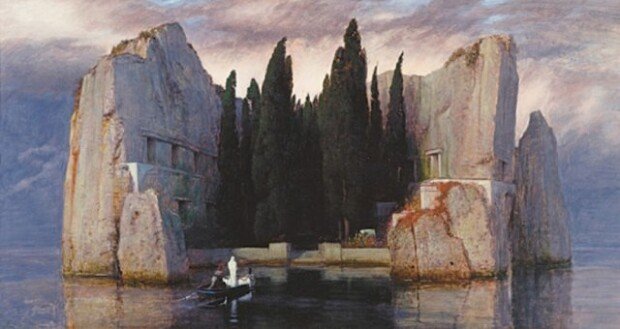The fear and pain of loss
The fear and pain of loss
Posted July. 01, 2021 07:26,
Updated July. 01, 2021 07:26

Death is feared as an afterlife is unknown. Swiss symbolist painter Arnold Böcklin depicted an afterlife as a rock island with cypress trees. He painted five pieces with the same title and same structure. How could the painter draw a life after death that he hadn’t experienced? Why was he so obsessed with the topic of death?
Böcklin born in Basel studied in Germany and later painted in Germany, Italy, and Switzerland throughout his life. He lived in Florence for nine years from 1876 where he painted “Isle of the Dead.” He completed the first version at the age of 53 in 1880 for his patron but kept the painting himself for unknown reasons. Later, a woman named Marie Berna who lost her husband was moved by the painting and ordered the second version, to which Böcklin added the coffin and female figure on a boat heading to the island. It symbolizes both death and condolences. The most popular is the third version drawn three years later. It depicts a rocky island in the most detailed and realistic way. Adolf Hitler had owned it for some time. The dreamlike isle of the dead is not a real place -- it is an image imagined by the painter, combining a British cemetery in Florence and mysterious rocky islands in Montenegro.
Böcklin was obsessed with death as he experienced death too frequently. He had 14 children with his wife, five of whom died at a young age and three of whom died before Arnold Böcklin himself. The British cemetery, which inspired the painting, is a burial place of his infant daughter Maria. Perhaps, the real reason death is feared is the tremendous sense of loss and pain that those left behind feel. Böcklin began to paint “The Island of Life” in 1888 as if he wanted to get away from the fear of death. His new painting showcasing the joy and happiness of life must have been his efforts to comfort others who were also left behind.






![“설거지해도 그대로”…냄비 ‘무지개 얼룩’ 5분 해결법 [알쓸톡]](https://dimg.donga.com/c/138/175/90/1/wps/NEWS/IMAGE/2026/01/15/133164664.3.png)
